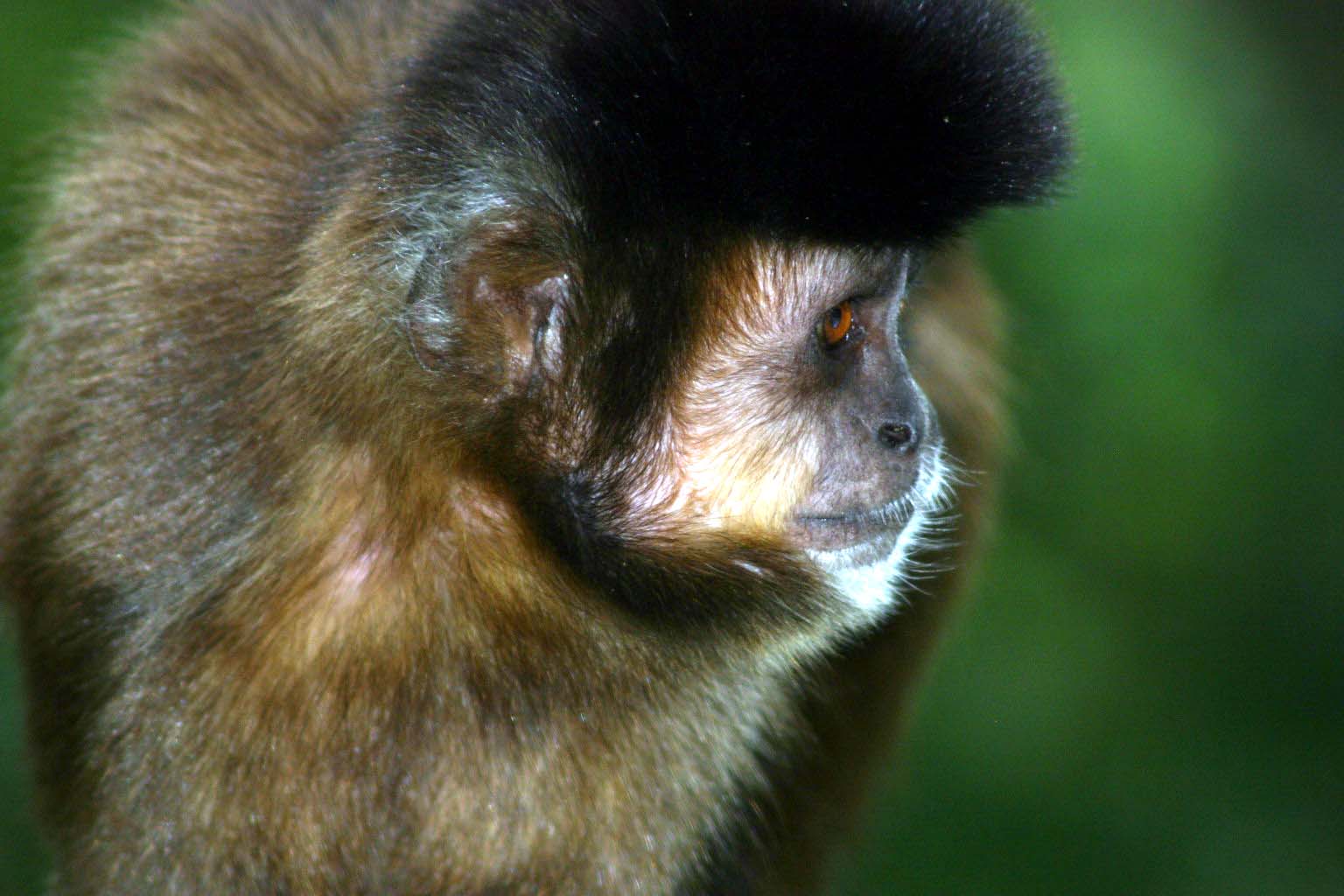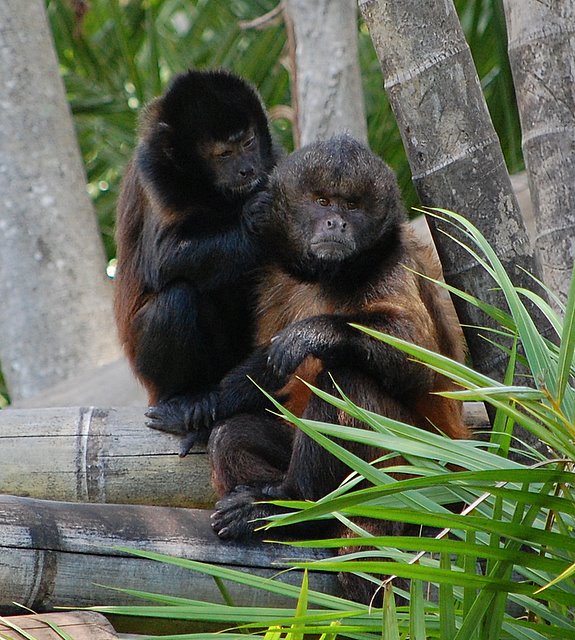|
Santa Ana Zoo
The Santa Ana Zoo at Prentice Park in Santa Ana, California, is a zoo focusing on the animals and plants of Central and South America. The Santa Ana Zoo hosts more than 270,000 people annually. The zoo opened in 1952 and is owned and operated by the City of Santa Ana. Joseph Prentice donated land for the zoo with the stipulation that the city must keep at least 50 monkeys at all times. The zoo maintains an extensive primate collection with over a dozen species from around the world. The focus of the Santa Ana Zoo is recreation, education, and conservation. It was previously accredited by the Association of Zoos and Aquariums (AZA). History Joseph Edward Prentice bought the site. He donated to the city of Santa Ana in 1949 and stipulated that the zoo have at least fifty monkeys at all times. Construction of the zoo began that year, and it opened on March 8, 1952. A children's zoo was soon built and the Flight Aviary, now known as the Jack Lynch Aviary, was completed in 1962 ... [...More Info...] [...Related Items...] OR: [Wikipedia] [Google] [Baidu] |
Santa Ana, California
Santa Ana () is the second most populous city and the county seat of Orange County, California. Located in the Greater Los Angeles region of Southern California, the city's population was 310,227 at the 2020 census, making Santa Ana the 13th-most populous city in California and the 4th densest large city in the United States (behind only New York City, San Francisco, and Boston). Santa Ana is a major regional economic and cultural hub for the Orange Coast. Santa Ana's origins began in 1810, when the Spanish governor of California granted Rancho Santiago de Santa Ana to José Antonio Yorba. Following the Mexican War of Independence, the Yorba family rancho was enlarged, becoming one of the largest and most valuable in the region and home to a diverse Californio community. Following the American Conquest of California, the rancho was sold to the Sepúlveda family, who subsequently lost their land claim. In 1869, William H. Spurgeon then purchased the rancho and formally ... [...More Info...] [...Related Items...] OR: [Wikipedia] [Google] [Baidu] |
Ring-tailed Lemur
The ring-tailed lemur (''Lemur catta'') is a large strepsirrhine primate and the most recognized lemur due to its long, black and white ringed tail. It belongs to Lemuridae, one of five lemur families, and is the only member of the ''Lemur'' genus. Like all lemurs it is endemic to the island of Madagascar and endangered. Known locally in Malagasy as ' (, spelled ' in French) or ', it inhabits gallery forests to spiny scrub in the southern regions of the island. It is omnivorous and the most terrestrial of extant lemurs. The animal is diurnal, being active exclusively in daylight hours. The ring-tailed lemur is highly social, living in groups of up to 30 individuals. It is also female dominant, a trait common among lemurs. To keep warm and reaffirm social bonds, groups will huddle together. The ring-tailed lemur will also sunbathe, sitting upright facing its underside, with its thinner white fur towards the sun. Like other lemurs, this species relies strongly on its sen ... [...More Info...] [...Related Items...] OR: [Wikipedia] [Google] [Baidu] |
Night Monkey
Night monkeys, also known as owl monkeys or douroucoulis (), are nocturnal New World monkeys of the genus ''Aotus'', the only member of the family Aotidae (). The genus comprises eleven species which are found across Panama and much of South America in primary and secondary forests, tropical rainforests and cloud forests up to . Night monkeys have large eyes which improve their vision at night, while their ears are mostly hidden, giving them their name ''Aotus'', meaning "earless". Night monkeys are the only truly nocturnal monkeys with the exception of some cathemeral populations of Azara's night monkey, who have irregular bursts of activity during day and night. They have a varied repertoire of vocalisations and live in small family groups of a mated pair and their immature offspring. Night monkeys have monochromatic vision which improves their ability to detect visual cues at night. Night monkeys are threatened by habitat loss, the pet trade, hunting for bushmeat, and by ... [...More Info...] [...Related Items...] OR: [Wikipedia] [Google] [Baidu] |
Tufted Capuchin
The tufted capuchin (''Sapajus apella''), also known as brown capuchin, black-capped capuchin, or pin monkey is a New World primate from South America and the Caribbean islands of Trinidad and Margarita. As traditionally defined, it is one of the most widespread primates in the Neotropics, but it has recently been recommended considering the black-striped, black and golden-bellied capuchins as separate species in a new genus, thereby effectively limiting the tufted capuchin to the Amazon basin and nearby regions. However, the large-headed capuchin (''S. a. macrocephalus''), previously defined as a distinct species, has been reclassified as a subspecies of the tufted capuchin, expanding its range east to Peru & Ecuador and south to Bolivia. The tufted capuchin is an omnivorous animal, mostly feeding on fruits and invertebrates, although it sometimes feeds on small vertebrates (e.g. lizards and bird chicks) and other plant parts. It can be found in many different kinds of enviro ... [...More Info...] [...Related Items...] OR: [Wikipedia] [Google] [Baidu] |
Crested Capuchin
The crested capuchin or robust tufted capuchin (''Sapajus robustus'') is a species of robust capuchin monkey. It is endemic to Brazil. It was formerly considered a subspecies of the black capuchin but is now considered by some to be a separate species. Taxonomy and phylogeny When the crested capuchin was discovered, it was formally classified as ''Cebus apella robustus'' and considered a subspecies of the tufted capuchin. In 2001, Groves proposed that the crested capuchin was a subspecies of the black capuchin and should be moved to ''Cebus nigritus robustus.'' In 2012, it was proposed that the genus ''Cebus'' should be split and that all robust capuchins should be under the genus ''Sapajus''. Additionally, it was also argued that the crested capuchin is a separate species from the black capuchin, and therefore the new classification for the crested capuchin should be ''Sapajus robustus''. It has also been estimated using mitochondrial DNA that the crested capuchin diverged from ... [...More Info...] [...Related Items...] OR: [Wikipedia] [Google] [Baidu] |
Black Howler
The black howler (''Alouatta caraya'') or black-and-gold howler, is among the largest New World monkeys and a member of the '' Alouatta'' genus. The black howler is distributed in areas of South America such as Paraguay, southern Brazil, eastern Bolivia, northern Argentina, and Uruguay. This species is sexually dimorphic, with adult males having entirely black fur and adult females and babies of both sexes having an overall golden colouring; which emphasizes black-and-gold in the name. The IUCN Red List has classed the black howler as Near Threatened as a result of a recent population reduction due to a variety of human-caused factors. Taxonomy The black howler is one of nine species of the '' Alouatta'' genus that have been identified and is in the Atelidae family. Because of this species' sexual dimorphism, the taxon for the black howler has been distinguished. * ''Alouatta caraya'' * '' Alouatta pigra'' * ''Alouatta seniculus'' * ''Alouatta arctoidea'' * ''Alouatta ... [...More Info...] [...Related Items...] OR: [Wikipedia] [Google] [Baidu] |
White-faced Saki
The white-faced saki (''Pithecia pithecia''), called the Guianan saki and the golden-faced saki, is a species of the New World saki monkey. They can be found in Brazil, French Guiana, Guyana, Suriname and Venezuela. This species lives in the understory and lower canopy of the forest, feeding mostly on fruits, nuts, seeds, and insects. Although they are arboreal creatures and are specialists of swinging from tree to tree ( brachiation), they are also terrestrial when foraging. White-faced sakis typically live around 14 years in their natural habitat and have been recorded to live up to 36 years in captivity. Sakis are active in the day and sleep highly elevated (15-20m) in trees with many leaves to shelter them from weather and flying predators. A formerly recognized subspecies of this monkey, ''P. p. chrysocephala'', was elevated to full species status as '' P. chrysocephala'' in 2014. Reproduction and Sexual Dimorphism In captivity, female white-faced sakis experience ovarian ... [...More Info...] [...Related Items...] OR: [Wikipedia] [Google] [Baidu] |
Titi
The titis, or titi monkeys, are New World monkeys of the subfamily Callicebinae, which contains three extant genera: ''Cheracebus'', ''Callicebus'', and ''Plecturocebus.'' This subfamily also contains the extinct genera ''Miocallicebus, Homunculus'', and ''Carlocebus''. Titi monkeys live in South America, from Colombia, Ecuador and Peru, east through Brazil, and south to Bolivia and northern Paraguay. Description Depending on species, titis have a head and body length of , and a tail, which is longer than the head and body, of . The different titi species vary substantially in coloring, but resemble each other in most other physical ways. They have long, soft fur, and it is usually reddish, brownish, grayish or blackish, and in most species the underside is lighter or more reddish than the upperside. Some species have contrasting blackish or whitish foreheads, while all members of the genus ''Cheracebus'' have a white half-collar. The tail is always furry and is not prehensile. ... [...More Info...] [...Related Items...] OR: [Wikipedia] [Google] [Baidu] |
Red-handed Tamarin
The golden-handed tamarin (''Saguinus midas''), also known as the red-handed tamarin or Midas tamarin, is a New World monkey belonging to the family Callitrichidae. Distribution and habitat This species is native to wooded areas north of the Amazon River in Brazil, Guyana, French Guiana, Suriname, and possibly Venezuela. A population of tamarins south of the Amazon River that lack the contrasting feet and hands was previously believed to be a sub-population of golden-handed tamarins but is now treated as a separate species, the black tamarin. Populations of golden-handed tamarins appear to be expanding into the historical range of the pied tamarin, with the golden-handed tamarin gradually displacing the pied tamarin through interspecific competition. This species prefers trees with small crowns. Description The golden-handed tamarin's body measures ; including the tail it measures . It weighs . The fur of the golden-handed tamarin is dark brown or black, with contrasting gold ... [...More Info...] [...Related Items...] OR: [Wikipedia] [Google] [Baidu] |
Golden-headed Lion Tamarin
The golden-headed lion tamarin (''Leontopithecus chrysomelas''), also the golden-headed tamarin, is a lion tamarin endemic to Brazil. It is found only in the lowland and premontane tropical forest fragments in the state of Bahia, and therefore is considered to be an endangered species. It lives at heights of . Its preferred habitat is within mature forest, but with habitat destruction this is not always the case. Several sources seem to have different information on the number of individuals within a group, and the type of social system that may be apparent. The golden-headed lion tamarin lives within group sizes ranging from 2 to 11 individuals, with the average size ranging from 4 to 7.Baker AJ, Bales K, Dietz JM. (2002). Mating system and group dynamics in lion tamarins. In: Kleiman DG, Rylands AB, editors. ''Lion Tamarins: biology and conservation.'' Washington DC: Smithsonian Institution Press. p 188-212. According to various sources, the group may consist of two adult males ... [...More Info...] [...Related Items...] OR: [Wikipedia] [Google] [Baidu] |
Emperor Tamarin
The emperor tamarin (''Saguinus imperator'') is a species of tamarin allegedly named for its resemblance to the German emperor Wilhelm II. It lives in the west Brazilian states of Acre and Amazonas and the southwest Amazon Basin, in east Peru, north Bolivia. The fur of the emperor tamarin is predominantly grey colored, with yellowish speckles on its chest. The hands and feet are black and the tail is brown. Outstanding is its long, white beard, which extends to both sides beyond the shoulders. The animal reaches a length of , plus a long tail. It weighs approximately . Physical description (''Saguinus imperator imperator'') Black-chinned emperor tamarin There are claws on each of the animal's toes and fingers, aside from its big toe which has a nail. While it has a definitive long mustache, it also has almost inconspicuous white hairs on its chin. Visually, however, the saguinus imperator has a black chin. The hair on its chest and belly are a mixture of red, orange, and whi ... [...More Info...] [...Related Items...] OR: [Wikipedia] [Google] [Baidu] |








